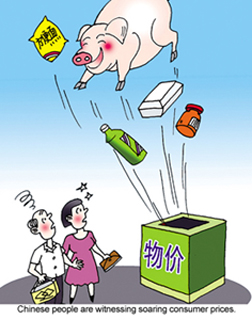Beginning in August 2007, the growth rate of Chinese consumer
price index (CPI) remained above 6 percent and hit a decade-high,
reaching 6.9 percent in November. This was a definite warning sign
that the Chinese economy would probably soon see the end of its
golden period.
 |
China, however, was not the only country to fall victim to high
inflation. Most of the world experienced high CPIs in 2007.
Statistics from US authorities indicated that the US' CPI rose by
0.8 percent in November 2007, raising it 4.3 percent higher than in
2006. This inflation rate caused the interest rate, which the US
government had lowered to 4.25 percent earlier, to become
technically negative. In the Euro region, the CPI increased by 2.6
percent in October, exceeding the maximum limit of 2 percent that
the European central bank could bear. A report made by China's
National Development and Reform Commission (NDRC) said that during
September and October seven countries had CPIs higher than 5
percent: Russia (10.8 percent), South Africa (9.7 percent),
Argentina, Vietnam, Indonesia, India? and China. Therefore,
the so-called BRICs, except Brazil, as indicated by the data have
fallen victim to rampant inflation.
What caused such wide spread inflation around the globe? The
NDRC has cited several factors, including excessive liquidity,
depreciation of the US dollar, decreased crop production by some
agricultural exporters, biofuel created agro-demand hikes and
production curtailments on the part of oil-rich OPEC members, among
many other factors. All these reasons drove up global commodity
prices of petroleum, grain, edible oil and iron ores; inflation was
the inevitable outcome. Lu Zhengwei, an analyst with the Industrial
Bank Co., Ltd., analyzed China's November CPI, producer price index
(PPI), retail price index (RPI) and corporate goods price index
(CGPI). He pointed out that the increasing price of crude oil was
behind November's rising indexes. Even the US' increasing CPI and
PPI in November can be attributed to oil price hikes.
Ironically, those major exporters running highly profitable oil
businesses also cannot escape from high inflation. According to an
October report released by the International Monetary Fund (IMF),
the United Arab Emirates' inflation rate reached 10 percent and
Saudi Arabia's hit a decade high. Qatar's inflation hit rates of 15
percent and 13 percent respectively in the first and second
quarters of 2007, the highest among the Gulf countries. With their
great dependence upon oil exports, these countries received
depreciating green backs from global markets and meanwhile had to
use appreciating euros to buy necessities from various European
markets. The result: "imported inflation".
The situation in China is similar to the above oil exporters to
some extent. China is one of the world's major exporters and
annually exports large quantities of goods ranging from daily
necessities to automobiles to precise equipment. With low
production costs and cheap yuan, China has seen its trade surplus
as well as its foreign reserves soaring recently. Consequently,
excessive currency supplies have appeared in the financial market
and the yuan has become cheaper inside the domestic market while
also appreciating against the US dollar. This process is causing
internal consumer products to become increasingly expensive.
In addition, some external factors have also pushed consumer
prices up. China's real estate industry experienced an
unprecedented boom in 2007. Increasing quantities of land were
developed, causing land supplies to fall short of demands.
Therefore, land prices went up, leading to price increases for
agricultural foodstuffs. Meanwhile, oil prices continued to rise in
the global market. The US passed the Energy Independence and
Security Act of 2007 emphasizing the use of biofuels, nudging
up grain prices. Under pressures from home and abroad, China's
consumer prices could not help rising. This has greatly impacted
upon the lives of ordinary Chinese.
During 2008, Chinese people, whether acting as investors or not,
are very likely to put more efforts toward fighting against rampant
inflation. Most Chinese investors believe that the money they
invest in the stock market is inflation-proof. But, as matter of
fact, it is not: stocks are as fragile as anything else in the face
of inflation.
Specifically speaking, as currency supplies increase at the very
beginning of inflation, consumer prices rise and the listed
companies then rake in more profits, pushing up share prices.
Outwardly, the stock markets are booming. But as inflation
continues and eventually reaches a rate of 10 percent or above,
fewer people will be willing to invest in the stock market.
Moreover, in the interim economic order is disturbed: enterprises
see their profits shrinking in real terms and experience trouble
with cash flow, causing the stock markets to experience a downturn
and possibly even a collapse. In fact, few stock analysts believe
inflation can generate a bullish stock market, whether in developed
markets, such as the US, or in emerging markets, such as India,
where returns on shares in both regions are very poor or even
negative amid high inflation. Stock markets turn bullish only when
the economy maintains rapid growth with low inflation.
Significantly, stocks are by no means inflation-proof but
commodities ranging from soybeans to petroleum to gold are all
resistant to value depreciation.
(China.org.cn by Pang Li, January 8, 2008)